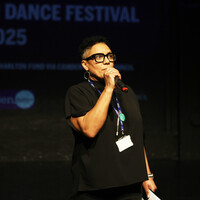Q + A with Anna Helsby, Director of Student Lifecycle and Well-Being at London Contemporary Dance School
News Story
Anna Helsby – Director of Student Lifecycle and Well-Being at London Contemporary Dance School – shares more about the Contemporary Dance Performance BA, and how students are supported to reach their potential at the school.
What sets London Contemporary Dance School apart?
LCDS has never been afraid of pushing forward. If you look at the Contemporary Dance Performance BA programme from five years ago, compared to the artistic programme it is now, it’s very different. We're here to push the boundaries of what contemporary dance can be. A big part of LCDS is to keep it moving forward, and not getting stuck in what it was. It means we’re innovative, and students become graduates who have relevance in the current and future industry.
How would you describe the Contemporary Dance Performance BA?
The BA provides students with world-leading dance training. The purpose of the course is to train dancers, choreographers, teachers and producers for the world of contemporary dance today. It’s to provide them with the skills that will enable them to have a successful portfolio career, which is likely to lead them down different pathways as they progress through their career.
How do you prioritise student wellbeing at London Contemporary Dance School?
We provide on-site facilities to support all aspects of student wellbeing, and we offer services from physio to counselling. Periodisation is woven into the training here, which is all about helping dancers manage their training to prevent injury and burnout. But we also do academic research to look closely at the physical and emotional wellbeing of students. Since 2019, we’ve had an ongoing academic research project looking at wellbeing and cognitive load, as well as the physical load. We take snapshots throughout the year of students’ wellbeing and physical status. There are different trends that come up, which include the impact of sleep, the transition from sixth form to higher education, and meeting new friends. We take all the data we collect, analyse it, then feed it directly into improving the programme and student support available.
Tell us more about the wellbeing services available at London Contemporary Dance School.
Student support for mental health and wellbeing, as well as physical support and learning support, are available for all students. We encourage students to seek support at an early stage. The support is there for students to access at any point in their studies, and we’re proud of the wide range of support that we offer. This includes access to mental health advisors, counsellors, an injury psychologist, a nutritionist, an osteopath, a physiotherapist, soft tissue massage sessions, athletic development and rehab coaches, plus learning support. This all gives students the necessary support they need at any point in their studies.
What are the main questions prospective students have about LCDS?
The main questions we get from prospective students are about the dance practices, and how much dancing they’ll be doing each day. We’re able to give them a comprehensive overview of the dance practices that we offer. And generally, student have between four and five classes a day, which last around an hour and a half each. Of these classes, usually three or four will be practical, depending on the day and where they are in their course. Dancing doesn’t just mean doing a technique class, but it can cover a wide variety of different sessions such as improvisation, choreography, chorology and practice-based research.
What is the feeling like at London Contemporary Dance School?
The faculty and staff members know the students well, and are all very supportive of each other. Students are listened to and the student voice carries a lot of weight. The small cohort sizes mean that the students know each other well and are able to bond too. There are a lots of societies and extra-curricular things that happen that the students are able to get involved with.
How does London Contemporary Dance School prepare students for their future careers?
This is an industry where most people have freelance careers. Some prospective students – and their parents – worry about this. They’re concerned they won’t have a regular income. Actually, there’s a lot more flex in the industry now. We have a lot of people who work for us who are on three day a week contracts, and they do their freelance dance jobs at other times. We also teach students how to balance their freelance career overlap. They might be doing three or four things at the same time, so getting them to understand how to manage themselves – whether it’s their CVs and getting work, or managing their health and wellbeing through periodisation – is really important.
Describe what is different about LCDS graduates.
Our graduates are very entrepreneurial. They’re able to take chances to be people who influence the industry in different ways. They have skillsets that graduates from other schools might not have, as they have been exposed to different styles and ways of working. This gives them the ability to work in lots of different settings, as well as independently.
We’re proud of the wide range of support that we offer. This includes access to mental health advisors, counsellors, an injury psychologist, a nutritionist, an osteopath, a physiotherapist, soft tissue massage sessions, athletic development and rehab coaches, plus learning support.



